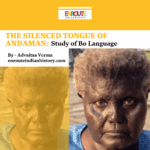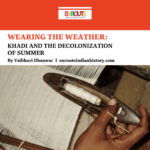
By Advaitaa Verma
The Andaman and Nicobar Islands is a union territory of India, comprising 572 islands, of which only 38 are inhabited. Basically, the island is grouped into two main clusters: the northern Andaman island and the southern Nicobar islands; these clusters are separated by a 150 kilometer wide channel. It is believed that the name Andaman derived from Handuman, after the Indian God Hanuman from the epic, Ramayana (Sircar, 2021). The place was also called with a similar name by the Malay, who were involved with slave trade with this region. In the 2nd century CE, Ptolemy refers to this place as Angademan and Marco Polo refers to this place as Angamanian in 13 th century CE (Murthy, 2005). Historically, Andaman has not been an important island; genetic and cultural studies suggest that indigenous Andamanese people may have been living in isolation from other populations during the Middle Palaeolithic (50,000 BCE). Archaeological evidence suggests early civilisations dating back to 300-200 BCE. The
Nicobar Islands was located at an important sea trade route, connecting South India to Southeast Asia, but there are very few accounts that mention such relations, including Fa Xian in 6th century CE and I-Tsing in 7th century CE (Sircar,2021). The reason behind fewer accounts and no local accounts is that the Andamanese people did not have a writing script but just oral tribal languages which are now lost or are either becoming extinct. So, there are more stories, songs, folklore and myths that talk about trade and history of this region.
Language is more than just a tool for communication; it is a repository of history, identity, and worldview, and something that binds the people of a region. The loss of a language signifies the erosion of an entire way of life. The case of Bo, a Great Andamanese language, illustrates the devastating effects of colonialism, displacement, and modernization on indigenous linguistic traditions. This article delves into the history, structure, and extinction of Bo, shedding light on the broader crisis of linguistic endangerment and loss.
The Historical Context of the Bo Language
Presently, the Andamanese people speak about a dozen endangered Andamanese languages, and these languages belong to two families: Great Andamanese and Ongan; but these families are unrelated to each other or any other language group. However, the majority of the population are immigrant languages speakers which include Bengali, Tamil, Telugu, Hindi, Malayalam, Sadri and Kurrukh; Hindi is the official language of the region and English is considered an additional official language for the purpose of communication especially for trade purposes. Bo language, also known as Akabo is an extinct dialect of the northern Andamanese language and was spoken
on the west central coast of North Andaman. The Bo language belonged to the Great Andamanese language family, spoken by the indigenous people of the Andaman Islands. The word Aka at the beginning of the language is a common Great Andamanese prefix, used for words related to the tongue or languages. The Great Andamanese once consisted of ten distinct tribes, each with its own dialect or language. These tribes, including the Bo people, lived as
hunter-gatherers for thousands of years, largely isolated from the outside world (Murthy, 2005). The population size of the Bo tribe in 1858 was 200 individuals, but the arrival of British colonialists in the 19th century marked the beginning of rapid decline for these communities. British occupation of the islands led to forced resettlement, disease outbreaks, and cultural disruption. By the late 20th century, only a few surviving members of the Great Andamanese
tribes remained; according to the 1901 census, only 48 individuals survived, many of whom had lost fluency in their ancestral languages. The census takers were told that due to an epidemic that came from Kora and Kari tribes; Bo resorted to killing all of their own who showed symptoms of the epidemic. Bo was one of these languages, gradually giving way to Hindi and other dominant languages. By 2006, the cultural and linguistic identity of the tribe had all disappeared, due to intermarriages and other factors. Boa Sr., a woman the last fluent speaker of Bo, was born in the
1920s. She witnessed the gradual erosion of her community's language and traditions. With her passing in 2010, Bo ceased to exist as a spoken language, joining the growing list of extinct indigenous languages worldwide (Murthy, 2005).
Linguistic Structure of Bo
Bo, like other Great Andamanese languages, exhibited a unique linguistic structure distinct from Indo-European or Dravidian languages spoken in mainland India. Some of its notable features included:
● Agglutinative Morphology: Words in Bo were formed by adding multiple affixes to a root, allowing for complex expressions.
● Pronoun-Based Noun Classification: Like other Great Andamanese languages, Bo categorized nouns based on body-part associations, an uncommon linguistic trait. For example, objects could be classified based on whether they were associated with the head, hand, or leg.
● Limited Phoneme Inventory: Bo had a relatively small set of consonants and vowels compared to major world languages.
● Oral Tradition: The language had no written script, relying entirely on oral transmission through stories, songs, and folklore (Abbi, 2018).
Extinction of Bo
The extinction of Bo was not an isolated incident but rather a culmination of historical, social, economic, and political factors that led to erosion of cultural and linguistic traditions of its speakers. Several key factors contributed to its decline:
● British Colonialism: One of the most significant reasons behind the decline of this language was British Colonial rule in this region. The arrival of the British in 1858 led to the forced resettlement of indigenous Andamanese, this is because the British established penal settlements in the Andaman Islands, bringing thousands of convicts, soldiers, and administrators, this disrupted their traditional ways of life and linguistic continuity. The British saw the indigenous Andamanese as obstacles to their colonial ambitions, they forcibly relocated them and the Bo people were among those who lost their ancestral land, which played a crucial role in their cultural and linguistic identity.
● Epidemics and Population Decline: Imported diseases like measles and influenza devastated the Great Andamanese population, reducing the number of native speakers. The outbreak of such diseases killed the indigenous people.
● Language Shift: With forced resettlement, the people came into contact with speakers of Hindi, Bengali, and other mainland languages. With time the younger generations increasingly adopted Hindi, the dominant language of India, which provided better opportunities for communication, employment, and social integration. With Hindi
becoming the dominant language, there was little incentive for younger generations to learn Bo, leading to its gradual disappearance.
● Lack of Institutional Support: The post-independence Indian government, while acknowledging the presence of the Great Andamanese, did not implement strong measures to preserve their languages. Unlike some indigenous languages that have benefited from formal documentation, educational programs, or legal protection, Bo received little institutional support. Although some scholars, such as Anvita Abbi, documented parts of the language before its extinction.
● Decline in Oral Storytelling and Cultural Practices: Bo contained a rich oral tradition, including songs, myths, and folklore that were passed down from one generation to the next. However, with the decline of the Bo-speaking population, the practice of oral storytelling also diminished. Boa Sr., the last fluent speaker of Bo, often recalled that she had no one left to converse with in her language. Without active speakers using Bo in daily life, its vocabulary and grammar were not being reinforced in younger generations, leading to decline of language (Abbi, 2018).
Efforts to Document and Revitalize Endangered Languages
While Bo is now extinct, its legacy lives on through linguistic documentation and efforts to preserve other Great Andamanese languages. Scholars such as Anvita Abbi have recorded words, songs, and stories from Boa Sr. before her passing. These records serve as an invaluable resource for understanding the language, this is how Bo language was documented and preserved. Several linguistic organizations have created digital databases to store endangered language materials, ensuring that knowledge of Bo remains accessible to everybody. While Bo itself cannot be
revived, efforts are underway to preserve other Great Andamanese languages by encouraging younger community members to learn and use them (Abbi, 2013).
Languages like Bo encapsulated a unique worldview shaped by the Andamanese people's environment and way of life. Their oral traditions contained rich ecological knowledge about the flora and fauna of the islands, survival techniques, and spiritual beliefs. Additionally, the Bo language played a crucial role in social organization and identity among the Great Andamanese. Traditional songs and myths reinforced communal bonds, while linguistic expressions encoded moral and ethical values. With the language's extinction, much of this cultural heritage is now lost or fragmented. The loss of Bo meant not only the disappearance of words but also the extinction of an entire system of understanding the world. The extinction of the Bo language is a stark reminder of the fragile nature of linguistic diversity. It reflects the larger struggles faced by indigenous communities worldwide in the face of
colonization, modernization, and cultural assimilation. While it is too late to save Bo, lessons from its loss can inform future language preservation efforts. By investing in linguistic documentation, supporting indigenous communities, and fostering multilingual education, we can prevent the further disappearance of the world’s linguistic heritage.
The silencing of Bo is not just the loss of a language—it is the loss of an entire way of seeing and interacting with the world. As we move forward, it is crucial to recognize the value of every language and the knowledge it carries, ensuring that no more voices are lost to history.
References
Abbi, A., 2013. A grammar of the Great Andamanese language: an ethnolinguistic study (Vol.4). Brill.
Abbi, A., 2018, June. A sixth language family of India: Great Andamanese, its historical status and salient present-day features. In The Dynamics of Language: Plenary and focus lectures from the 20th International Congress of Linguists (p. 134). Juta and Company (Pty) Ltd.
Annamalai, E. and Gnanasundaram, V., 2001. Andamanese: Biological challenge for language reversal. MULTILINGUAL MATTERS, pp.309-322.
Murthy, R.V.R., 2005. Andaman and Nicobar Islands: Development and Decentralization. Mittal Publications.
Sircar, P.K., 2021. History of the Andaman Islands: Unsung

















